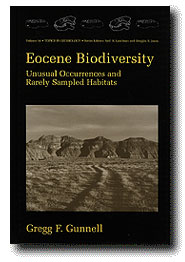Eocene Biodiversity:
Unusual Occurrences
and Rarely Sampled Habitats
by Gregg F. Gunnell (editor)
Topics in Geobiology vol. 18
Kluwer Academic / Plenum
Publishers, New York, 2001, 442 p.
ISBN 0-306-46528-0. $95.00 |
 |

The Eocene is a fascinating epoch, with an exceptional fossil record that documents
the appearance and evolution of many groups of modern mammals and the decline
of unique Paleocene animals, such as the uintatheres. During the Eocene global
climates shifted rapidly, with several periods of global warming, which present
us with obvious opportunities to study faunal and floral responses to shifting
temperatures. However, in spite of the density of the terrestrial fossil record
during this time interval from several continents, most discussion implicitly
refers to the well-studied record from the western U.S. The papers collected
in this volume attempt to broaden our knowledge of the Eocene by documenting
uncommon depositional environments and areas outside of the 'classic' American
Eocene localities in the Bighorn, Wind River, Green River, and Uinta Basins.
The volume is the result of a symposium held at the
Society of Vertebrate Paleontology (SVP) meetings in Utah in
1998, and includes sixteen contributions. Of these, five deal with non-North
American localities: the exceptional Messel oil shale, with chapters on the
taphonomy (Franzen) and paleobiology (Storch); the unusual kimberlite pipe fauna
at Mahenge in Tanzania; the Chambi locality in Tunisia, and the Gandhera Quarry
in Baluchistan. These contributions vary in the amount of detail they provide.
Hartenberger et al. present a very short summary of the fauna and geology at
Chambi, while Harrison et al. provide a considerably more detailed discussion
of the history of collection, geology and taphonomy of the lacustrine faunas
found in kimberlite pipes in Tanzania. These two localities provide an important
window on the Eocene of Africa, as much of our current knowledge is derived
from the Fayum biota, and additional information is welcome. The report on Gandhera
Quarry is a brief preliminary report, but this locality has high diversity for
an early Eocene mammalian assemblage, and it has the potential to be an important
window on the diversification of modern mammal orders. The papers reporting
on Messel touch on the paleoclimate of Lake Messel and the unique preservational
situation (Franzen), and the paleoecology of the fauna (Storch). Sadly, the
figures in these two contributions suffer from the use of ordinary, non-glossy
paper, such that the generally superb photos of the Messel specimens look dark
and flat and features are difficult to see. It is unfortunate that the figures
were not adjusted to compensate for the choice of paper.
The remaining chapters concern North American localities. By far the largest
grouping consists of taphonomic analyses of unusual facies found in the classic
sections of Utah and Wyoming. These include analyses of microvertebrate faunas
found in freshwater limestones in the Willwood Formation in the Clark's Fork
Basin (Bloch and Bowen), concentrations of microvertebrates in the Willwood
Formation in the Bighorn Basin (Silcox and Rose), stratigraphy and taphonomy
of classic localities at Grizzly Buttes in the Bridger Formation (Alexander
and Burger) and the Gnat-Out-of-Hell locality in the Uinta Formation (Thornton
and Rasmussen). Although these papers are diverse in their interpretations of
the depositional environments involved, they generally focus on the smaller
mammals, and provide a different perspective on the relative abundance of taxa
at different time intervals during the early and middle Eocene. Three papers
present taphonomic analyses of mass death assemblages. The most straightforward
to interpret appear to be catastrophic mass death assemblages of Meniscotherium
(Williamson), which are found in floodplain fluvial deposits. More complex depositional
environments appear to have been involved in the case of the Omomys Quarry in
the Bridger Formation (Murphey et al.), with a complex history of events in
the case of Roehler's Coryphodon Catastrophe Quarry in the Wasatch Formation
(McGee). Grande's paper on the Green River Formation presents a systematic overview
of the teleost fauna of the Great Lakes complex, which also suffers from the
photographic limitations mentioned above. He provides an interesting summary
of the differences among the faunas of the three different lake faunas found
in the Green River, which serves as a useful introduction for those among us
who see the specimens everywhere yet know little about the deposit.
By far the most intriguing paper is Gunnell and Bartels' study of basin margin
deposits in the Rocky Mountain Interior. They compared terrestrial vertebrate
faunas from the margin of the Green River Basin with those found in the basin
center, and have found important differences between the two environments. Faunas
from the basin margin have higher species richness than those found in the basin
center. Taxa that are rare in the basin center are frequently common in the
basin margin faunas, and in several cases, taxa that appear to be ancestor-descendant
species found in separate time intervals in the basin center appear contemporaneously,
sometimes with morphological intermediates, in the basin margin faunas. The
authors also suggest that these assemblages may represent a more diverse environment,
one which promotes speciation. The migration of new species from the basin margin
to the basin center might explain their sudden appearances in basin center faunas.
It's an intriguing idea, and I look forward to further tests of the hypothesis.
Clearly, these faunas have important implications for mammalian biostratigraphy
in this region, and although a great deal of work has been done, much remains.
This book is an interesting collection of papers for fans of the Eocene, in
spite of the problems with some of the figures. The Gunnell and Bartels chapter
deserves to be widely read, but I suspect the remaining papers will be of more
interest to the specialist than a general paleontology audience.
